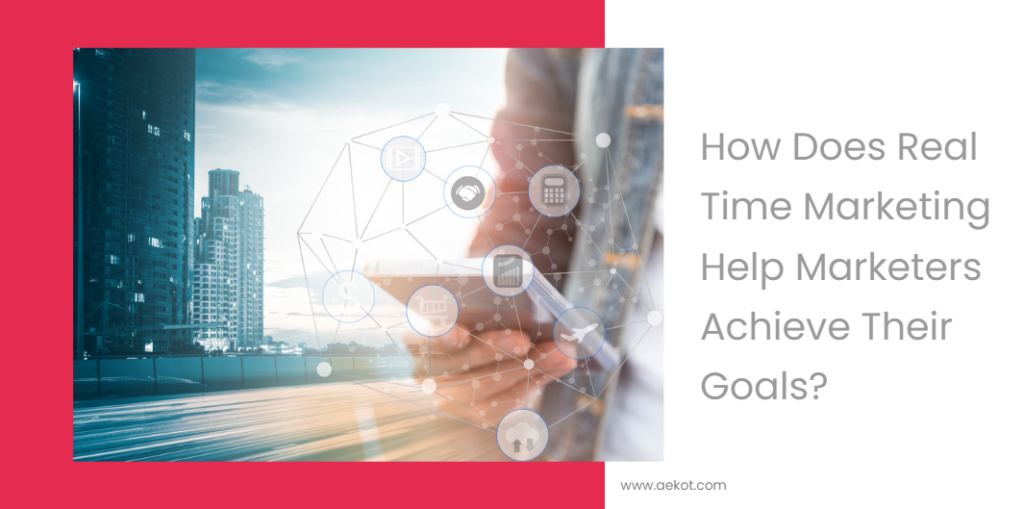
In today’s fast-paced business world, real-time data and real-time marketing are essential for businesses to stay competitive and make informed decisions. Real-time data refers to data that is available immediately, as it happens, and can be analyzed and acted upon in real-time.
Real-time marketing, on the other hand, refers to marketing strategies that are executed in real-time, based on real-time data insights. It’s a practice of creating and delivering timely, relevant, and personalized marketing messages to customers in real-time. It involves using data and technology to monitor customer behavior and preferences in real-time, and then using this information to deliver personalized marketing messages to customers at the right time and on the right channel.
The goal of real-time marketing is to create a sense of urgency and relevance for customers, by delivering messages that are tailored to their specific needs and interests at the moment they need them. For example, if a customer is browsing a website for a particular product, a real-time marketing message might appear on the page offering a discount or special promotion for that product.
Here are some reasons why businesses need real-time data and real-time marketing:
Agility and Responsiveness
With real-time data, businesses can quickly respond to changes in the market, consumer behavior, and competition. For instance, if a company notices a sudden spike in demand for a product, they can quickly ramp up production to meet the demand. Similarly, real-time marketing enables companies to respond quickly to market changes and consumer behavior, allowing them to adjust their marketing strategies and messaging in real-time.
Personalization
Real-time data and marketing enable businesses to deliver personalized experiences to customers, based on their real-time behavior and preferences. By tracking a customer’s browsing history and purchase behavior in real-time, businesses can create personalized product recommendations, targeted ads, and personalized messaging.
Improved Customer Experience
Real-time data can help businesses identify pain points in the customer journey and take immediate action to address them. If a customer is having trouble with the checkout process, a business can use real-time data to identify the issue and fix it quickly, improving the customer experience.
Better Decision Making
Real-time data provides businesses with accurate and up-to-date information, enabling them to make better decisions. By analyzing real-time sales data, businesses can quickly identify which products are selling well and adjust their inventory and production accordingly.
Real-time marketing data can help businesses identify the most effective marketing channels and messaging, allowing them to allocate their marketing budgets more effectively.
Competitive Advantage
Real-time data and marketing can provide businesses with a competitive advantage by allowing them to act quickly and make informed decisions. By leveraging real-time data and marketing, businesses can launch targeted campaigns and promotions that resonate with consumers and stay ahead of the competition.
Real Time Data And CDP
A Customer Data Platform (CDP) is a marketing technology platform that is designed to collect, unify, and activate customer data across multiple channels and touchpoints. With the ability to process real-time data, a CDP can help marketers deliver personalized and relevant experiences to their customers in real-time.
Here are some of the key things that can be done with a CDP using real-time data:
Real-time campaign optimization
With the ability to process real-time data, a CDP can help marketers optimize their marketing campaigns in real-time. This means that marketers can use real-time data from the CDP to make adjustments to their campaigns in real-time, and improve their performance. For instance, if a marketing campaign is not performing well, a marketer can use real-time data from the CDP to identify the problem and make adjustments to the campaign in real-time.
Real-time insights
With the ability to process real-time data, a CDP can provide marketers with real-time insights into customer behavior and preferences. This means that marketers can track customer behavior across different channels in real-time, and use this information to make data-driven decisions about their marketing campaigns. A marketer can use real-time data from the CDP to identify the problem and make adjustments in real-time.
Real-time segmentation
A CDP can also help marketers segment their customers in real-time based on their behavior and preferences. This means that as customers interact with a brand across different channels, the CDP can collect and process data about their behavior and preferences, and use this information to segment them into different groups.
This can help marketers deliver targeted and relevant messages to each segment in real-time. If a customer has recently made a purchase, the CDP can use this data to segment them into a group of loyal customers, and deliver personalized offers and content to this group in real-time.
Real-time attribution
A CDP can also help marketers measure the effectiveness of their marketing campaigns in real-time. By tracking customer behavior across different channels in real-time, a CDP can provide marketers with real-time attribution data, which can help them understand the impact of their marketing efforts on customer behavior.
For example, if a customer sees an ad on social media and then makes a purchase on the website, the CDP can attribute the sale to the social media ad and provide real-time data on the effectiveness of the ad.
In conclusion, real-time marketing is a powerful strategy that can help marketers deliver timely and relevant messages to customers across multiple channels. By leveraging data, technology, and automation, marketers can engage with customers at every stage of the customer journey, and deliver personalized experiences that drive conversions and improve customer loyalty.
